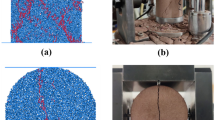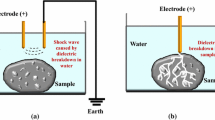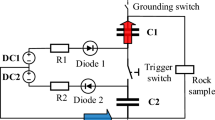Abstract
With the deepening of the development of natural resources, the difficulty of rock breaking is increasing. Novel efficient rock-breaking technology and matching rock-breaking tools are urgently needed. The high-voltage pulsed fragmentation (HVPF) method has high efficiency and great development potential. So, it has attracted wide attention. However, the unclear understanding of the relationship between the mechanism of HVPF, the design and parameter optimization of HVPF tools, and rock-breaking energy consumption also impede the commercial progress of this technology. In this paper, the electrical crushing is subdivided into “partial electrical breakdown” (PEB) and “complete electrical breakdown” (CEB) from electrical breakdown process (EBP), and the mechanism of PEB is proposed. Finally, a method, which is named as voltage partitioned method (VPM), for designing and optimizing parameters of the HVPF tools is provided. The results of numerical simulation and electrical breakdown experiment can well support the mechanism of PEB. The mechanism of PEB provides a basis for the application of multi-pulse electrical breakdown technology. The VPM establishes the relationship between voltage loading parameters, electrode structure parameters and rock electrical parameters, which can provide reliable help for the design and parameter optimization of HVPF tools.























Similar content being viewed by others
Abbreviations
- CBS:
-
Complete breakdown strength
- CEB:
-
Complete electrical breakdown
- EPB:
-
Electro-pulse-boring
- PCD:
-
Plasma channel drilling
- TBS:
-
Threshold breakdown strength
- VPM:
-
Voltage partitioned method
- CBV:
-
Complete breakdown voltage
- DBM:
-
Dielectric breakdown model
- HVPF:
-
High-voltage pulse fragmentation
- PEB:
-
Partial electrical breakdown
- TBV:
-
Threshold breakdown voltage
- EBP:
-
Electrical breakdown process
- C 1 ~ C 4 :
-
Capacitance
- E d :
-
Channel internal drop field strength
- E pc :
-
Partial threshold breakdown strength
- E s :
-
Complete breakdown strength
- h :
-
Depth of the plasma channel
- J m :
-
Current density modulus
- L 11 ~ L 32 :
-
Inductance
- R :
-
Tip curvature radius of electrode
- U :
-
Potential
- U s :
-
Complete breakdown voltage
- ε 0 :
-
Dielectric constant of the vacuum
- ρ :
-
Space charge density
- D e :
-
Damage degree of rock
- E ps * :
-
Testing value of partial CBS
- n s :
-
Attenuation factor of partial CBS
- ε max :
-
Upper limit of the relative permittivity
- E c :
-
Threshold breakdown strength
- E p :
-
Partial electric field
- E ps :
-
Partial complete breakdown strength
- H :
-
Electrode spacing/Rock thickness
- I :
-
Current
- L :
-
Electrode spacing/Inductance
- p B :
-
Breakdown probability
- t :
-
Time
- U c :
-
Threshold breakdown voltage
- U p :
-
Peak loading voltage
- ε r :
-
Relative dielectric constant
- σ :
-
Conductivity
- D e :
-
“Electrical damage” factor
- n c :
-
Attenuation factor of partial TBS
- N :
-
Number of discharges
- ε min :
-
Lower limit of relative permittivity
References
Andres U (1995) Electrical disintegration of rock. Min Proc Ext Met Rev 14(2):87–110. https://doi.org/10.1080/08827509508914118
Andres U, Timoshkin I, Jirestig J, Stallknecht H (2001a) Liberation of valuable inclusions in ores and slags by electrical pulses. Powder Technol 114(1):40–50. https://doi.org/10.1016/S0032-5910(00)00260-6
Andres U, Timoshkin I, Soloviev M (2001b) Energy consumption and liberation of minerals in explosive electrical breakdown of ores. Min Proc Ext Met Rev 110(3):149–157. https://doi.org/10.1179/mpm.2001.110.3.149
Badger Explorer ASA. Badger explorer concluded testing on plasma channel drilling technology. https://www.rigzone.com/news/oil_gas/a/63218/badger_explorer_concluded_testing_onplasma_channel_drilling_technology/
Biela J, Marxgut C, Bortis D, Kolar JW (2009) Solid state modulator for plasma channel drilling. IEEE Trans Dielect Electri Insul 16(4):1093–1099. https://doi.org/10.1109/TDEI.2009.5211860
Boev S, Vajov V, Levchenko B, Jgun D, Muratov V, Peltsman S et al (1997) Electropulse technology of material destruction and boring. IEEE Int Pulsed Power Conf. https://doi.org/10.1109/PPC.1997.679311
Boev S, Vajov V, Jgun D, Levchenko B (2002) Destruction of granite and concrete in water with pulse electric discharges. Pulsed Power Conference, 1999. Digest of Technical Papers. IEEE International, 2:1369–1371, IEEE. https://doi.org/10.1109/PPC.1999.823782
Burkin VV, Kuznetsov NS, Lopatin VV (2006) Analysis of mechanisms of rock destruction in electro discharge drilling. Izv Vyssh. Uchebn. Zaved. Fiz 11:507–510
Burkin VV, Kuznetsova NS, Lopatin VV (2009a) Dynamics of electro burst in solids: i. power characteristics of electro burst. J Phys D Appl Phys 42(18):185204 (6 pp.)-185204 (6 pp.)185204 (6 pp.). https://doi.org/10.1088/0022-3727/42/18/185204
Burkin VV, Kuznetsova NS, Lopatin VV (2009b) Dynamics of electro burst in solids: ii. characteristics of wave process. J Phys Appl Phys 42(23):235209. https://doi.org/10.1088/0022-3727/42/23/235209
Cho SH, Yokota M, Ito M, Kawasaki S, Jeong SB, Kim BK et al (2014) Electrical disintegration and micro-focus x-ray ct observations of cement paste samples with dispersed mineral particles. Miner Eng 57:79–85. https://doi.org/10.1016/j.mineng.2013.12.019
Cho SH, Cheong SS, Yokota M, Kaneko K (2016) The dynamic fracture process in rocks under high-voltage pulse fragmentation. Rock Mech Rock Eng 49(10):3841–3853. https://doi.org/10.1007/s00603-016-1031-z
Duan CL, Diao ZJ, Zhao YM, Huang W (2015) Liberation of valuable materials in waste printed circuit boards by high-voltage electrical pulses. Miner Eng 70:170–177. https://doi.org/10.1016/j.mineng.2014.09.018
Gao D (2003) Prospect of technology and subject specialty of petroleum drilling. Exploration Engineering (Drilling & Tunneling). https://doi.org/10.3969/j.issn.1672-7428.2003.z1.003 (in Chinese)
Kusaiynov K, Nussupbekov BR, Shuyushbayeva NN, Tanasheva NK (2017) On electric-pulse well drilling and breaking of solids. Tech Phys+ 62(6):867–870. https://doi.org/10.1134/S1063784217060184
Kuznetsov YuI, Vazhov VF, Zhurkov MYu (2011) Electrical breakdown of solid dielectrics and rocks on the trailing edge of a voltage pulse. Russ Phys j+ 54(4):410–415. https://doi.org/10.1007/s11182-011-9632-1
Li C, Duan L, Tan S, Chikhotkin V (2018) Influences on high-voltage electro pulse boring in granite. Energies 11:2461. https://doi.org/10.3390/en11092461
Li C, Duan L, Tan S, Chikhotkin V, Fu W (2019) Damage model and numerical experiment of high-voltage electro pulse boring in granite. Energies 12:727. https://doi.org/10.3390/en12040727
Lisitsyn, IV, Inoue H, Katsuki S, Akiyama H, Nishizawa I (2002) Drilling and demolition of rocks by pulsed power. In: IEEE International Pulsed Power Conference. IEEE. https://doi.org/10.1109/PPC.1999.825439
Liu W, Zhu X, Li B (2018) The rock breaking mechanism analysis of rotary percussive cutting by single pdc cutter. ARAB J GEOSCI 11:192. https://doi.org/10.1007/s12517-018-3530-6
Macgregor S, Turnbull S (2007) Plasma channel drilling process. US Patent: US7270195 B2
Money WM, Hill LG (2009) Method of drilling using pulsed electric drilling. US Patent: US7530406
Niemeyer L, Pietronero L, Wiesmann HJ (1984) Fractal dimension of dielectric breakdown. Phys Rev Lett 52(12):1033–1036. https://doi.org/10.1103/physrevlett.52.1033
Petrov YV, Morozov VA, Smirnov IV, Lukin AA (2015) Electrical breakdown of a dielectric on the voltage pulse trailing edge: investigation in terms of the incubation time concept. Tech Phys+ 60(12):1733–1737. https://doi.org/10.1134/S1063784215120178
Phloymuk N, Pruksanubal A, Tanthanuch N (2013) DC breakdown voltage of solid dielectric barrier under non-uniform electric field. In: 2013 IEEE Conference on Electrical Insulation and Dielectric Phenomena—(CEIDP 2013). IEEE. https://doi.org/10.1109/CEIDP.2013.6748208
Schiegg HO, RØdland A, Zhu G, Yuen D (2015) Electro-pulse-boring (EPB): novel super-deep drilling technology for low cost electricity. J EARTH SCI-CHINA. https://doi.org/10.1007/s12583-015-0519-x
Sun Y, Fu R, Fan A, Gao Y, Yan P (2015) Study of rock fracturing generated by pulsed discharging under confining pressure. In: Pulsed Power Conference. IEEE, pp 1–4. https://doi.org/10.1109/PPC.2015.7296927
Timoshkin IV, Mackersie JW, Macgregor SJ (2004) Plasma channel miniature hole drilling technology. IEEE Trans Plasma Sci 32(5):2055–2061. https://doi.org/10.1109/TPS.2004.835489
Touzé S, Bru K, Ménard Y, Weh A, von der Weid F (2016) Electrical fragmentation applied to the recycling of concrete waste-effect on aggregate liberation. Int J Miner Process. https://doi.org/10.1016/j.minpro.2016.11.009
Vazhov VF, Gafarov RR, Datskevich SY, Zhurkov MY, Muratov VM (2010) Electric-pulse breakdown and the breakage of granite. Technical Physics c/c of Zhurnal Tekhnicheskoi Fiziki. https://doi.org/10.1134/S1063784210060149
Voitenko NV, Yudin AS, Kuznetsova NS, Krastelev EG (2016) How to increase the efficiency of the electrical discharge method for destruction of nonconductive solid materials. Phys Atom Nucl 79(14):1632–1636. https://doi.org/10.1134/S1063778816140167
Walsh SDC, Vogler D (2020) Simulation electropulse fracture of granitic rock. IJRMMS 128(2020):104238. https://doi.org/10.1016/j.ijrmms.2020.104238
Wiesmann HJ, Zeller HR (1986) A fractal model of dielectric breakdown and prebreakdown. J Appl Phys 60(5):1770–1773. https://doi.org/10.1063/1.337219
Yan F, Lin B, Zhu C, Guo C, Zhou Y, Zou Q et al (2016) Using high-voltage electrical pulses to crush coal in an air environment: an experimental study. Powder Technol 298:50–56. https://doi.org/10.1016/j.powtec.2016.05.023
Zhang Z, Pei Y, Liu Z, Wang K, Liu B, Yan K (2012) Experimental research on rock breakdown under short high-voltage pulse. High Voltage Eng 38(7):1719–1725. https://doi.org/10.3969/j.issn.1003-6520.2012.07.027 (in Chinese)
Zhang R, Hu Q, Liu S, Hu X (2017) Discharge characteristics of high voltage pulses inside rocks with increasing their applied number. AIP Adv 7:115014. https://doi.org/10.1063/1.5000777
Zhao L, Su J, Zhang X, Pan Y (2012) Experimental investigation on the role of electrodes in solid dielectric breakdown under nanosecond pulses. IEEE Trans Dielect El in 19(4):1101–1107. https://doi.org/10.1109/tdei.2012.6259976
Zhu X, Luo YX, Liu W (2019) The rock breaking and rop increase mechanisms for single-tooth torsional impact cutting using DEM. Petrol Sci. https://doi.org/10.1007/s12182-019-0318-6
Zhu X, Luo YX, Liu W (2020) On the rock-breaking mechanism of plasma channel drilling technology. J PETROL SCI ENG 11(194):107356. https://doi.org/10.1016/j.petrol.2020.107356
Zuo W, Shi F, Manlapig E (2015a) Pre-concentration of copper ores by high voltage pulses. part 1: principle and major findings. Miner Eng 79:306–314. https://doi.org/10.1016/j.mineng.2015.03.022
Zuo W, Shi FN, Peter VDWK, Weh A (2015b) Ore particle breakage behaviour in a pilot scale high voltage pulse machine. Miner Eng 84:64–73. https://doi.org/10.1016/j.mineng.2015.09.025
Acknowledgements
This study is supported by the National Natural Science Foundation of China (Grant No.52034006; No.52004229), Science and Technology Cooperation Project of the CNPC-SWPU Innovation Alliance (2020CX040301), Scientific Research Starting Project of SWPU (2018QHZ015), Applied Basic Research of Sichuan Province (Free Exploration-2019YJ0520). Such supports are greatly appreciated by the authors.
Author information
Authors and Affiliations
Corresponding author
Additional information
Publisher's Note
Springer Nature remains neutral with regard to jurisdictional claims in published maps and institutional affiliations.
Appendix
Appendix
1.1 Appendix A
1.1.1 Calibration process of material parameters in simulation
The calibration process of material parameters in simulation will be introduced in this section. And the relative permittivity of the rock εR to measure the “electrical damage” in the simulation.When the amplitude of electric field strength inside the rock |Ep| is less than the partial TBS, the rock can’t be broken down, and the relative permittivity inside the rock is εmin. There is no damage inside the rock at this time. When the amplitude of electric field strength inside the rock |Ep| is larger than the partial CBS, the local rock area is completely electrically broken down, forming some “plasma channel branches” (it can be regarded as “electric fracture” or “electric damage”). At this time, to make the simulation converge, it is assumed that the relative permittivity of the breakdown domain of rock is a constant value εmax which is much larger than εmin. In the process of electrical breakdown, the relative permittivity inside the rock εR is between εmin and εmax, namely:
where εmin is the lower limit of relative permittivity, dimensionless; εmax is the upper limit of the relative permittivity, dimensionless; εR is the relative permittivity of the rock; |Ep| is the amplitude of electric field strength inside the rock; Epc is the partial TBS (V/m); Eps is the partial CBS (V/m).
In the process of electrical breakdown, the applied pulse voltage (the curve in Fig. 9) and the governing equation Eq. (4) drive the electric field (such as charge) inside the rock to change; the electric field distortion caused by the rock material equation and the “electrical damage” governing equation Eq. (5) reacts to the governing equation Eq. (4). In this way, the self-coupling between the electric field and the “electrical damage” is realized during the electrical breakdown, which reflects the non-uniform response of the rock to the electric field.
From the above analysis, the parameters that need to be determined in the electrical breakdown simulation of rock are the lower limit of relative permittivity εmin, the upper limit of relative permittivity εmax, the partial TBS and the partial CBS. The parameter calibration process is shown in Fig.
24. The specific calibration process is:
-
(1)
Setting the voltage as 50 kV in the electrostatic field, and the lower limit of the relative permittivity εmin is fixed at 6.5 (the relative permittivity of mica is 6–8), then the maximum field strength in the rock domain is measured at this time as 1.94 × 107 V/m, that is, the partial TBS (Epc = 1.94 × 107 V/m) is obtained.
-
(2)
Setting the voltage as 100 kV in the electrostatic field, and giving a testing value of the upper limit of relative permittivity εmax*, then the maximum field strength, which is called the testing value of the partial CBS Eps*, in the rock domain is extracted from the result.
-
(3)
Giving a pulse voltage with a peak value of 100 kV (i.e., Up = 100 kV), and substituting the parameters, which include the lower limit of the relative permittivity εmin, the partial TBS, the testing value of the upper limit of relative permittivity εmax* and the partial CBS Eps*, obtained in steps (1)-(2) into the rock material equation Eq. (5) to perform transient electrical breakdown simulation. Observing the “electrical damage” inside the rock after the electrical breakdown simulation (i.e., plasma channel). If the plasma channel does not penetrate the rock, slowly increase the testing value of the upper limit of relative permittivity εmax*; if the plasma channel penetrates the rock, slowly decrease the testing value of the upper limit of relative permittivity εmax*.
-
(4)
Repeating steps (2)-(3) until the plasma channel just penetrates the rock when Up = 100 kV, then the calibrated value of the upper limit of the relative permittivity εmax and the partial CBS can be obtained (i.e., εmax = εmax*, Eps = Eps*).
After multiple “trails and errors” calibration experiments, the calibration values of the upper limit of the relative permittivity and the partial CBS are εmax = 206.5 and Eps = 3.85 × 107 V/m, respectively.
1.2 Appendix B
1.2.1 Porosity tests of two kind of sandstones
The porosity tests of two kind of sandstones will be introduced in this section. And the measured porosity of the two kinds of sandstones is obtained using tap water immersion method. First, measure the masses M1 of the two remaining sandstones after coring. Then, the two rocks are soaked in tap water for 48 h and then taken out, and the mass M2 at this time is measured. Finally, the porosities of the two kinds of rocks are obtained according to the mass difference after and before the rock samples are immersed in water. The masses of the two rocks measured in the test are shown in Tables
3 and
4, respectively. The calculation formula of measured porosity is
where p is measured porosity, %; \(\Delta M\) is mass difference after and before the rock sample is immersed in water, kg; ρw is the density of tap water, and taking ρw = 1000 kg/m3 here; ρR is the density of the rock, and the density of red sandstone is 2086.7 kg/m3, while the density of lime sandstone is 2239.9 kg/m3.
Substituting the data in the “Total” row in Tables 3 and 4 into Eq. (6), the measured porosities of red sandstone and lime sandstone are 8.39% and 12.92%, respectively.
Rights and permissions
About this article
Cite this article
Zhu, X., Luo, Y., Liu, W. et al. On the Mechanism of High-Voltage Pulsed Fragmentation from Electrical Breakdown Process. Rock Mech Rock Eng 54, 4593–4616 (2021). https://doi.org/10.1007/s00603-021-02537-5
Received:
Accepted:
Published:
Issue Date:
DOI: https://doi.org/10.1007/s00603-021-02537-5





